A Honey of A Time

Did you know that there are 300 varieties of honey in the United States?
That, like wine, the flavor of honey is affected by the type of soil the flowers grow in, from which the pollen is plucked? (Different minerals add different nuances, and too much rain dilutes the flavor.)
Did you know that it takes a bee a lifetime to make one drop of honey?
That worker bees live for a mere 45 days?
But that queen bees live for 2 to 3 years? Talk about girl power.
I had a honey of a time learning all about the sticky nectar last week at Perbacco restaurant in San Francisco, where Chef Staffan Terje was kind enough to showcase honey in a special dinner for invited food writers and food bloggers, including my buddies, Single Guy Chef and Foodhoe’s Foraging.
To kick off the night, Bruce Wolk of the National Honey Board walked us through “Honey 101,” with a tasting of more than a half dozen different types of honeys. Yes, they were all super sweet. But the differences, magnified when trying them side by side, was remarkable not only in their hues, but in their flavors.
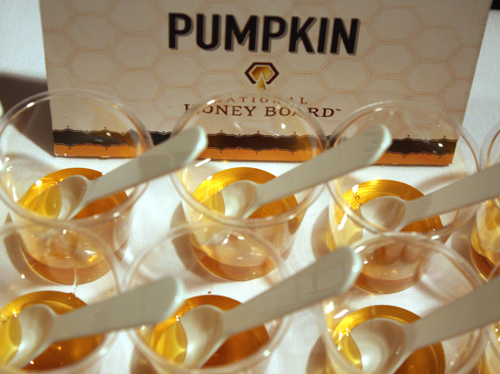
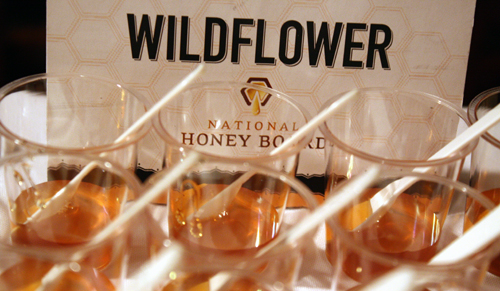
Blueberry honey — named for the blueberry blossoms that help make that particular honey, not because it actually tastes like blueberries — is found only in New Jersey. Its flavor is a little like maple syrup. Pumpkin honey, which is produced in small quantities only in California and Colorado, was a revelation with its amber color and caramel flavor. Avocado honey tasted musky, sort of like molasses. Tupelo — the only honey that doesn’t crystallize easily and is almost extinct because the shrubs needed to make it are so few in numbers now — has lovely floral and cinnamon notes.
Looking nearly like tar, buckwheat honey, nearly black in color, is one honey that Wolk said, “People either hate or love.”
I can see why. This unusual honey has the aroma of a fermented Asian sauce or perhaps a salted, dried plum. Its taste is like strong molasses or even dark, heavy Guinness.
In general, the darker colored the honey, the stronger the flavor and the higher the mineral content. Buckwheat honey has the most minerals of any honey, and therefore, the highest level of antioxidants, Wolk said.
Honey may be good for us, but most of us use it just because we love its flavor and voluptuous body.
Chef Terje sure does. His dishes that night were inspired by ones in Northern Italy that use honey.
“I’m from Sweden,” he explained. “I was the kid who stuck a spoon in the honey jar. That was my candy.”
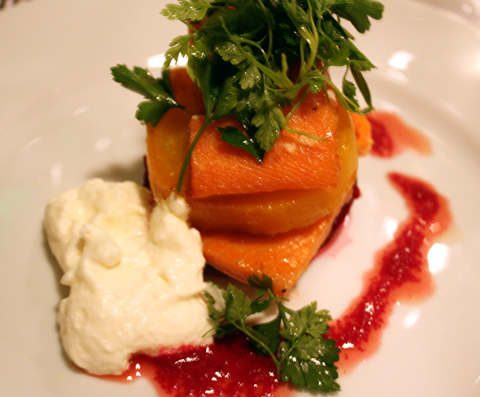
Dinner started with a magnificent tower of smoked trout that had been glazed with a little honey, and served with sweet, tender roasted beets and a poof of creamy horseradish foam.
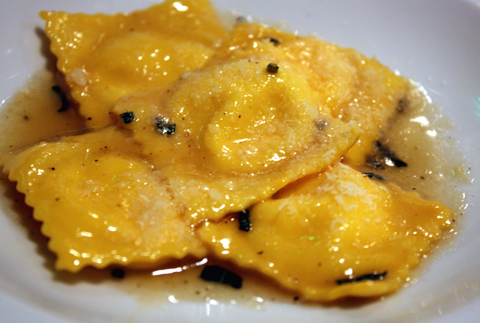
Agnolotti filled with sheep’s milk ricotta followed, tossed in nutty brown butter sauce laced with chestnut honey. I could have eaten seconds.
Good thing I didn’t or else I wouldn’t have had room for the delicate, snowy halibut that was poached in honey and Arneis, a floral Piedmontese wine. It was accompanied by artichokes cooked in a little thistle honey.
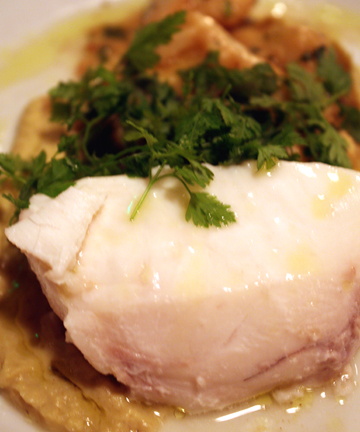
Next up was 36-hour honey and Barbera-glazed Wagyu short ribs with autumn vegetables. The meat was tender, yet still held its shape well.
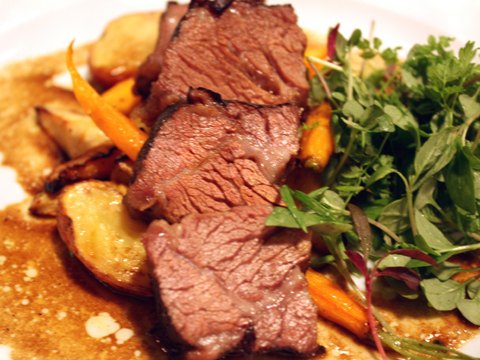
The evening ended with a dessert plate that held a tiny, crisp Italian donut hole with honey-caramel cream, a square of torrone semifreddo, and a most interesting honey panna cotta that was topped with a little milk. When you used your spoon to break through the wobbly custard, it became a unique mixture of solid and liquid.
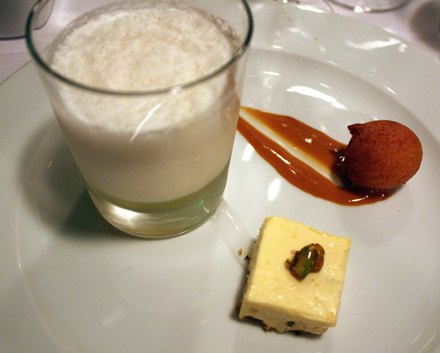
I don’t think I’ve ever had so much honey in one night.
How sweet it was.
I know I’ll never look at that squeezable plastic bear on the supermarket shelf quite the same way again.

Did the chef use specific varietals of honey in each dish, or did he use the bear?
Such enticing honey varieties!
I’m amazed at all the different flavors — and eager to try some!
No, I didn’t know! I love honey and always make sure to have at least three kinds at home…
What a wonderful meal!
Cheers,
Rosa
Pingback: Tweets that mention Food Gal » Blog Archive » A Honey of A Time -- Topsy.com
I have the squeezeball plastic bear in my pantry, top crystalized & crusty! I read that you should not nuke it in the microwave to liquify it as it loses much of its nutritional value. I’ll venture out and try more of the flavored honeys.
It was so much fun seeing you at the dinner! I’m curious how much honey Chef Terje used for each dish, because it was very balanced. I feel like trying different kinds of honey now after years of just what I find at Trader Joe’s.
wow thanks for the info on honey! i never knew there was so many different varieties and oh i do want to try the blueberry one! x
Honey is one of my favorite things ever! A sneaky snack I used to love was raw almonds dipped in honey…mmmm.
Regarding the blueberry honey, though, I must disagree – you can get that stuff all over Maine. New Jersey?! Psh.
I MUST find some buckwheat honey. I would drink straight molasses if it weren’t so horrific a concept so a deep, dark honey sounds right up my alley!
Sounds like an amazing evening. It’s amazing that the honey worked so well in all the different dishes…
I never used to be a big honey fan. But my mom brought us a European specialty honey last time she came to visit (I don’t remember the name), and I actually really enjoyed it.
Steve, re: “I read that you should not nuke it in the microwave to liquify it as it loses much of its nutritional value. ”
I’m skeptical. I poked around on the web and found a couple of sources that make this claim, but no scientific references.
Great post. I love trying different varieties of honey. I always get sucked in by blueberry honeys and chestnut honeys. It’s particularly fun with cheese pairing since you can match the terroir and somehow knowing what plants the bees pollenated (spelled wrong I think but you know what I mean. makes it all the more fun to eat and a little more romantic.
makes it all the more fun to eat and a little more romantic.
The National Honey Board’s brochure doesn’t address loss of nutrients from microwaving. But it does suggest what to do when honey becomes crystallized. The honey board folks recommend you place the honey jar in warm water and stir until the crystals dissolve. It says to take care not to boil or scorch the honey.
Anna, you can drink straight molasses?! Whoa!!
What a fun read – I love honey in all its varieties. My BIL just got me a broccoli honey which I cannot wait to dig into/.
Excellent dishes featuring honey! We love trying different kinds of honey, just a few weeks had a chance to do a little honey tasting in Maryland and I got to try the honey from killer bees! We bought a really nice wildflower local Maryland honey that I’ve been using in various dishes, should blog about it soon.
Natasha: You had honey from killer bees? Oh my! So do the beekeepers have to take extra precautions with those buzzing assassins?
Pingback: Foodhoe’s Foraging » A taste of honey
I love hearing about all these honey varieties! Pumpkin honey?? Yes, please!
Anna, if you are in the bay area, you should find Morganic Hill Honey: http://www.morganichill.com/
They are at the Cupertino farmer market on Friday (in the Sears parking lot), Saratoga’s farmer market on Saturday, and Mtn View on Sunday. I’m sure they travel farther too, check the webpage.
They definitely have buckwheat honey, although I’ve never tried it, and they have a huge selection of interesting honeys to choose from, at very fair prices. Their wildflower this year is very good – almost cinnamon-ish.
We’re fortunate to have a wonderful apiary/honey purveyor called Ames Farm. I fell in love with their creamed honeys, just to spread on toast. But from the dishes you’ve shown above, I’ve experienced a bare fraction of how honey can be used! Thank you for sharing!
Pingback: Foodie Networking for Maximum Impact « food4thought
Pingback: Food Gal » Blog Archiv » Exquisite Italian Small Plates at Barbacco at San Francisco